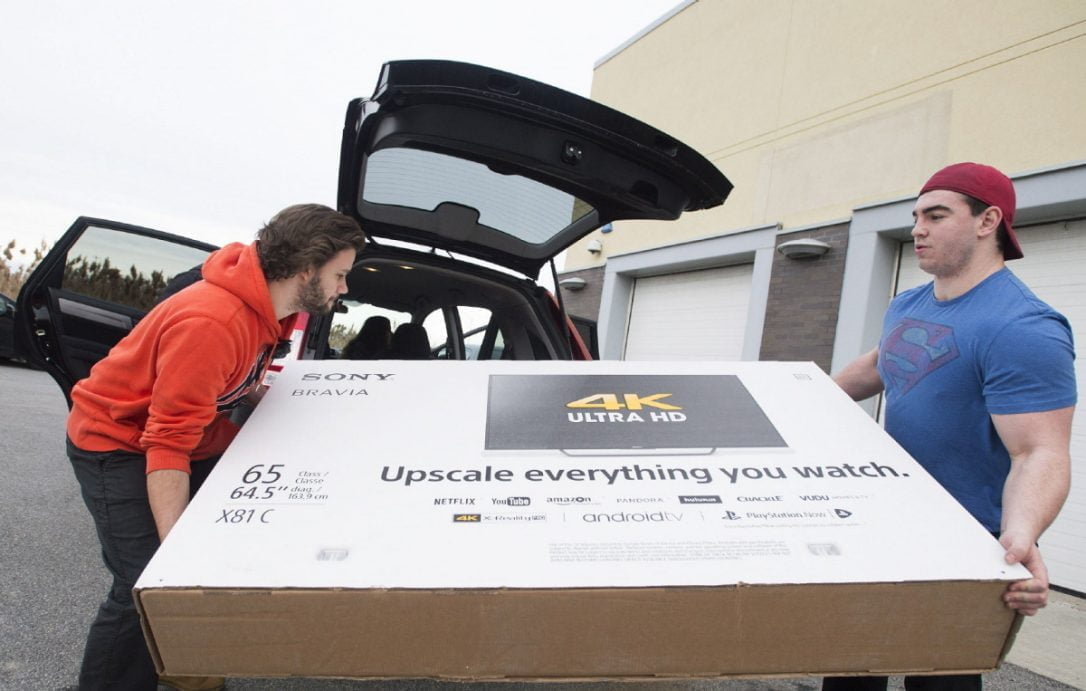TV Shopping Season’s Big Question: to 4K or Not to 4K?

Let’s start with the fact that there is never a perfect time to buy a TV. From Black Friday on through Boxing Day and into January, there are deals on all kinds of television sets.
One big reason is that in early January all the big TV manufacturers unveil their new models during the annual Consumer Electronics Show, which means the upgrade cycle begins anew.
This year there is an additional the conundrum facing consumers who are about to enter TV sales season: to 4K or not to 4K.
That new technology — which promises a TV picture sharper than HD — has made things even more bewildering for shoppers.
“TV used to be easy, it’s not any more,” said Phil Swann, an industry watcher and founder of TVpredictions.com. “Anything with TV technology right now — and has been for at least for five years or more — has become really complicated and very confusing.”
Swann said TVs becoming much more sophisticated devices than they used to be is largely to blame.
The good news is 4K TVs have been coming down in price, even taking into account the premium Canadians pay because of the sinking loonie. But price shouldn’t be the only factor you take into account.
Unlike 3D TVs, which spectacularly failed, 4K’s momentum is moving forward as manufacturers and broadcasters hop on board.
The Basics
4K usually means 3840 x 2160 pixels on a display, while most high-definition (HD) TVs display only 1920 x 1080 pixels. But it’s important to note that while 4K is a sharper picture, it’s not four times better. It is nowhere close to the eye-popping jump from standard definition to HD.
In fact, it’s about 20 to 25 per cent sharper, and even then some people say they can’t really see the difference. It works really well for close-up shots and is best on bigger TVs.
It’s also not just about the TV set. At this point, everything about 4K is at a premium. You will likely need to upgrade your set-top box from your cable provider (if you have one), and it also need a pretty strong level of Internet bandwidth into your home to deliver the signal.
Remember when HD signals started to appear on TV, and for some channels, there were standard definition counterparts? That’s likely the hybrid world we are heading into for the next few years.
So you’ll be watching mostly regular HD signals on your 4K TV. All the new 4K TVs do HD-upscaling, which should convert the signal to make it look good on the newer set. But results vary, and that is one area you should definitely look at in reviews of any set you are thinking of buying.
The colour factor
While 4K resolution has had all the buzz, the new player on the scene is High Dynamic Range (HDR), that is another feature you should be looking for. In fact, if you’re buying a TV, you should make sure it has it.
This is a fairly new development, and it has to do with how the colours look on your TV. This new TV technology is instantly noticeable, and is often supplies the “wow” factor on a newer TV’s picture.
There is just one problem: the TV manufacturers have not decided on a standard with this, and there are two competing visions: HDR 10 and Dolby Vision. Dolby Vision is the more ambitious of the two, but it is proprietary. HDR10 is more common.
As with 4K, content needs to be specifically made for this for maximum impact, and there is hope that TV manufacturers actually come to a decision about which to support. Some manufacturers and content creators are supporting both, like Netflix, as well as manufactures such as LG and Vizio.
This is definitely something to check and might be a reason worth waiting to see how it shakes out.
Content is king
No point in having 4K, if you can’t watch something shot in the higher-resolution format, is there? There are already an estimated 20 million 4K sets in North American homes, and still not that much content.
Sports has been at the forefront of 4K content, and fans of Toronto teams are likely one of the best-served 4K markets in North America. All Blue Jays homes games, many Raptors home games and several Leafs games are available on Bell and Rogers.
Just as consumers are trying to future-proof their technology, broadcasters want to do the same with their content. Bell, for example, has already said that all of its original scripted productions must be shot in 4K.
“It’s going to be coming quicker and you’re going to see more next year, because the U.S. television industry has bought in,” said Mary Ellen Carlyle, vice-president of Dome Productions, which has produced more than 200 4K broadcasts, including Toronto sporting events. “There will be even more in 2018. I can’t see us going backwards.”
Netflix jumped on 4K early, shooting House of Cards in the format and it continues to expand its library, which includes Stranger Things and Daredevil. It has promised 150 programs by years’ end, but it’s not there yet. One tracking site pegged the number currently at 26, although that is unconfirmed. Amazon’s original shows are also being shot in the format. Most movies for home rental or purchase are available in 4K Blu-ray mode, although do you want pay $20 to $30 for each disc?
“This might be a reason to wait, because you’re not missing out on a whole lot,” said Swann.
Gadgets galore
While broadcasters have to build out infrastructure to deliver channels, peripherals and online services will likely get more use out of 4K screens, at least initially.
“The thing that is going to drive 4K is all those little boxes, like the Rokus and the Google Chromecast — that’s what’s going to drive 4K quicker than the broadcasters,” said Carlyle.
The PS4 Pro just launched and it’s built to support 4K gaming. The Xbox One S can show 4K Blu-rays. The Roku 4 can support 4K streaming, and the just launched Chromecast Ultra from Google makes it easy to get YouTube’s 4K content onto your big screen.
In these early days, getting one of these in addition to a box from your cable or satellite provider is a good idea.
Bottom Line
In the U.S. prices for 4K TVs have come down a great deal, but there is still a bit of a premium in the Canadian market, usually about $500 from a HD to a 4K.
As an example, Swann said he bought a premium TV four months ago for $2,500 and it’s now selling for $1,799.
At this point, it’s still early to buy a 4K TV, but it should be part of your decision if you want to buy a TV.
“If you are in the market for a new TV, or if you are even close to buying a new TV, get a 4K TV,” said Swann.
“If you are very happy with your current television and had no plans on buying a TV for the next year, then wait.”








